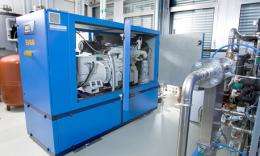Virtual power plants for renewable energies

Siemens recently put two virtual power plants into operation. Virtual power plants are networks of several small power stations that are run like a single system. One of the new virtual power plants enables the Munich municipal utility company to run six of its cogeneration modules, five hydroelectric facilities, and one wind-power plant more efficiently and economically than if they were operated separately. The facilities have a combined output of 20 megawatts. The second virtual power plant was set up for the utility company RWE and consists of a number of similar components to those in Munich. Although it will initially also have an output of 20 megawatts, the second virtual power plant will be expanded to 200 megawatts by 2015. The key component of each virtual power plant network is the distributed energy management system from Siemens.
When incorporated into smart grids, virtual power plants open up new possibilities for energy suppliers and operators of energy generation systems. The electricity produced in this manner can be traded on the European Energy Exchange in Leipzig, Germany, for example, or offered to other markets. Besides offering energy suppliers an additional way of selling electricity, virtual power plants also make the utilities more flexible. In addition, they can help improve grid stability by making controlling power available in the minute reserve range. Virtual power plants are ideally suited for renewable sources of energy. Since Germany's Renewable Energy Act was amended in January 2012, the associated market subsidy system encourages operators to sell electricity from their virtual power plants directly on the energy markets. As a result of the "energy revolution," the importance of virtual power plants in smart grids is expected to grow.
The distributed energy management system from the energy automation experts at Siemens uses sophisticated information and communications technology to network and combine the various decentralized power producers so that they can be centrally managed. To make this possible, the system processes all of the relevant information, including weather forecasts, current electricity prices, and energy demand. On the basis of this data, the system draws up an operation schedule for all of the associated facilities and monitors its implementation. The system updates its energy consumption prediction every hour, depending on the weather forecast and the type of day. The operation schedule minimizes the costs of generating electricity and operating the facilities within the virtual power plant network. In doing so, the system takes economic as well as environmental aspects into account.
Source: Siemens



















